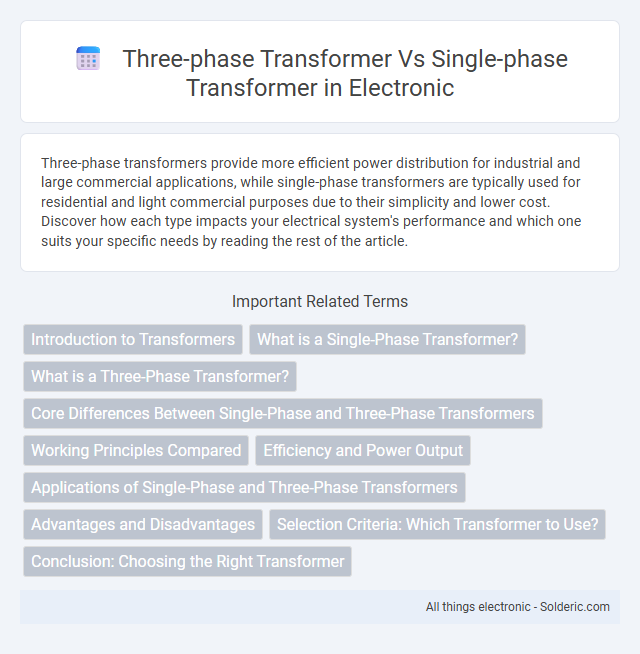Three-phase transformers provide more efficient power distribution for industrial and large commercial applications, while single-phase transformers are typically used for residential and light commercial purposes due to their simplicity and lower cost. Discover how each type impacts your electrical system's performance and which one suits your specific needs by reading the rest of the article.
Comparison Table
| Feature | Three-phase Transformer | Single-phase Transformer |
|---|---|---|
| Phase System | Three-phase | Single-phase |
| Power Rating | Higher (up to several MVA) | Lower (usually up to few kVA) |
| Construction | Three coils on a single core or three single-phase units | One coil on single core |
| Efficiency | Higher efficiency at high power | Lower efficiency at comparable ratings |
| Application | Industrial power distribution, large motors | Residential and small load appliances |
| Cost | Higher initial cost but economical for large loads | Lower initial cost for small loads |
| Size and Weight | Bulky but compact for power rating | Smaller and lighter for low power |
| Maintenance | More complex due to multiple windings | Simpler and easier |
Introduction to Transformers
Transformers are electrical devices designed to transfer electrical energy between circuits through electromagnetic induction, with three-phase transformers used primarily for power transmission in industrial and utility applications due to their efficiency in handling large loads. Single-phase transformers are typically employed in residential and light commercial settings where power demand is lower and simpler distribution is required. The choice between three-phase and single-phase transformers depends on factors like load capacity, application type, and system complexity.
What is a Single-Phase Transformer?
A single-phase transformer is an electrical device designed to transfer electrical energy between two circuits through electromagnetic induction, operating with a single alternating voltage phase. It typically consists of primary and secondary windings wrapped around a magnetic core, used primarily in residential and light commercial applications for stepping voltage up or down. Unlike three-phase transformers, single-phase transformers handle power for single-phase systems and usually have simpler construction and lower cost.
What is a Three-Phase Transformer?
A three-phase transformer is an electrical device designed to transfer power between three alternating current (AC) circuits simultaneously, using three sets of primary and secondary windings. It is commonly used in industrial and commercial power distribution systems to efficiently step voltage levels up or down while maintaining balanced load conditions. Compared to single-phase transformers, three-phase transformers offer improved efficiency, reduced material costs, and more compact design for handling large power demands.
Core Differences Between Single-Phase and Three-Phase Transformers
Single-phase transformers are designed for single alternating current (AC) voltage input and output, typically used in residential and light commercial applications, featuring one primary and one secondary winding on a simple laminated core. Three-phase transformers consist of three sets of primary and secondary windings, either combined in one core or assembled as three single-phase transformers, and are primarily used in industrial and high-power electric distribution systems to efficiently handle three-phase power supply. The core difference lies in their construction and application: single-phase transformers handle single-phase voltage with simpler design, while three-phase transformers accommodate three-phase voltages with a configuration optimized for balanced power distribution.
Working Principles Compared
Three-phase transformers operate by transferring power across three separate coils arranged in phases, providing balanced load distribution and higher efficiency for industrial and commercial applications. In contrast, single-phase transformers consist of a single coil pair, suitable for lower power requirements and simpler residential or light commercial use. Understanding your power needs helps determine whether a three-phase or single-phase transformer best optimizes energy transfer and system performance.
Efficiency and Power Output
Three-phase transformers typically offer higher efficiency and greater power output compared to single-phase transformers due to their balanced load distribution and reduced losses. Their design allows for continuous power transfer, minimizing energy waste and optimizing performance in industrial and commercial applications. Your choice between the two should consider the scale and load requirements, as three-phase transformers are better suited for large, high-demand systems.
Applications of Single-Phase and Three-Phase Transformers
Single-phase transformers are commonly used in residential and light commercial applications where power demand is relatively low, such as in household appliances and small office equipment. Three-phase transformers serve industrial and large commercial settings by efficiently handling higher power loads for equipment like motors, large HVAC systems, and manufacturing machinery. Your choice between these transformers depends on the specific power requirements and scale of the electrical system.
Advantages and Disadvantages
Three-phase transformers offer higher efficiency, reduced installation cost, and smaller size compared to three single-phase transformers, making them ideal for industrial power distribution and large-scale electrical systems. Single-phase transformers are simpler, easier to maintain, and more suitable for residential or light commercial applications where the power demand is lower. Your choice depends on load requirements, available space, and budget, balancing the complexity and efficiency of three-phase transformers against the simplicity and convenience of single-phase units.
Selection Criteria: Which Transformer to Use?
Selecting between a three-phase transformer and a single-phase transformer depends on the power system's load requirements and application type. Three-phase transformers are ideal for industrial settings and large power distribution networks where balanced loads and high efficiency are crucial, while single-phase transformers suit residential or light commercial applications with lower power demands. Consider factors such as voltage levels, load capacity, cost, and system complexity to determine the most suitable transformer type.
Conclusion: Choosing the Right Transformer
Selecting the right transformer depends on your specific power needs, with three-phase transformers offering higher efficiency, better power distribution, and suitability for industrial applications, while single-phase transformers are ideal for lower load, residential, and light commercial use. Three-phase transformers support balanced load and reduce power losses, making them cost-effective for large-scale energy transfer. Your choice should consider load requirements, installation complexity, and energy efficiency to ensure optimal performance and reliability.
three-phase transformer vs single-phase transformer Infographic

 solderic.com
solderic.com